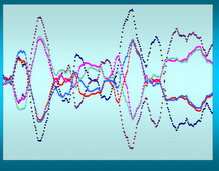Before we get to the results let me go over a couple of guidelines – this is based on daily close data not intra-day. That will make a difference.
I tested a lot of versions but only two showed any promise and I called them ATR y and ATR z. In the “y” version I used the approach - ATR(n) < ATR(n) 3 days ago. In the “z” version I used the approach - ATR(n) < ATR(n) 5 days ago.

Some were pretty good and some were pretty bad but as you can see for this approach ATR(10) seems to perform better. The 30-day net change was about the same for each of them so this is not necessarily a good filter for a long-term approach.
I noticed that 15 z seemed out of line so I decided to step down one period at a time from 14 to 10.

Even stranger 13 z was better than 14 z by a lot but then 12 z fell off again. So I said that the results might be date specific so I changed the start date so that February 27th would be included.

And the results fell in the same manner as before – ATR 10 is the best with ATR 13 following. I can’t explain this so we’ll just accept it as some mystery of the ATR (for the time being). Point is – ATR of a length 10 seems to be best as a short-term daily indicator.
I was surfing around looking at various sites and I happened across one site where the poster had an article suggesting using MACD with the ATR. That, to me is the best way to use the ATR – in concert with other indicators – I prefer the RSI, that guy likes the MACD. The fact is they both measure the same thing just one is more complex and a little slower than the other. Slow is good from the standpoint of a long-term relationship because slow ensures that you get on board a developed trend – but that is a matter of choice.

4 comments:
Tentative hypothesis for the outperformance of 10ATR: exactly half the length of the 20 day cycle?
That makes sense - thanks.
The original Turtle trading rules:
Stops: N=ATR(20). Stops are 2N from entry price. Note that this is not a trailing stop but a fixed stop for each entry. N was originally updated to most recent volatility values during the weekend for the next week.
Scale Ins: .5N from entry price, and raising previous stops on all previous entries by .5N, but 2N from the latest entry will normally cover all of the previous entries.
Entries: Voluntary to take a 20-day breakout ONLY if last breakout of any kind was not successful. But always take the 55-day breakout unconditionally.
Profit Exits: 20-day low for 55-day breakout. 10-day low for 20-day breakouts. Obviously, these exits will only overrule the ATR stops if theres significant profit.
Position Size: 2N represents 1% of equity and is a Unit, technically: 1% of equity / 2N * dollar value of contract (which is always $1 with stocks so its moot). 1% is rather large for stocks but may have been okay for leveraged futures back in 1983.
Limits: 4 units per market. 6 units per closely correlated marekts. 10 units for loosely correlated markets. 12 units for a single direction, long or short. "Market" may have to be redefined a little for stock purposes. Perhaps as: stock, industry, sector, market.
Observations: Plotting the stops and exits tell you a few things. Breakouts are naturally in an overbought state and very prone to pulling back and trigging the stops prematurely, which may explain why the Turtles never had a high win percentage (they were long-term). They likely were relying on those very few breakouts that never backfill much for the gigantic reward:risk ratio (JDSU anyone?). It might be better to wait for an oversold condition after a breakout signal. The stops appear to be way too close to the market, even at 2N from entry. Yet, there is clearly a difference between a fixed stop, the profit exits and a trailing stop. At least at the beginning, the Chandelier exit seems to approximate both the fixed stops and profit exits with ATR(10),3 which incidentlly makes money entering the market completely at random.
What'd I'm most keenly interested in knowing are the optimal values for the length of the ATR, the scale in multiplier, the fixed stop multiplier, the length for the profit exits, and whether or not trailing stops and Chandelier exits can be optimized to be superior to the original rules. And most importantly, optimized to a higher win percentage than 30%-60%.
MachineGhost
Interesting material
Post a Comment